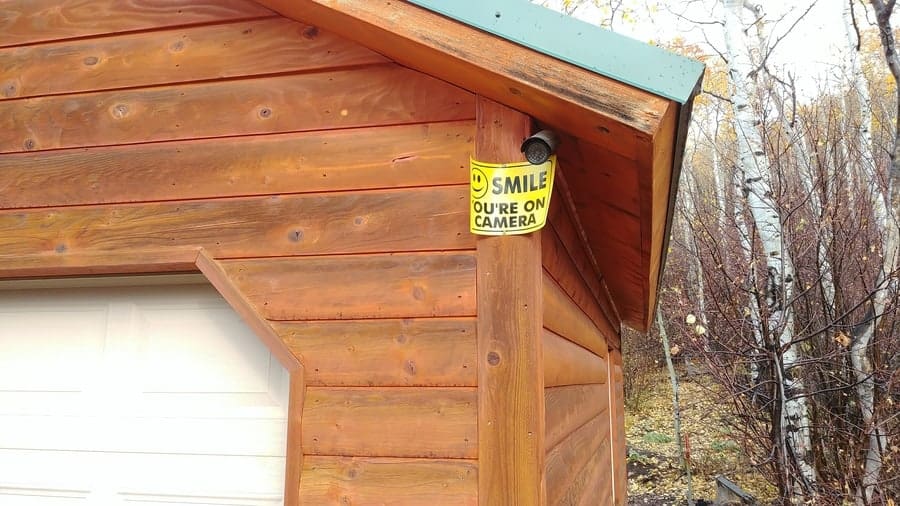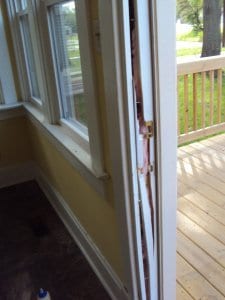
When I’m up at the cabin, I like to know I’m safe.
The outdoors can present some dangers that are uncommon in town. But it can also present some of the same dangers. I mean, how many horror films are there that take place in the woods. That’s because there’s something about being away from town that invokes a little more suspense, even fear.
That applies both in the movies and in real life. The outdoors is one of my favorite places to be. But it’s also harder to contact help and get a quick response if something does go wrong.
That’s why I like to make sure my cabin is safe and secure from potential intruders. When I’m away from the cabin, security is important to protect my property. But when I’m at the cabin with my family, security is even more important. That’s what this guide is all about. I’m going to help you know how to secure your cabin to keep yourself and your loved ones safe inside.
Reduce the Risk of Break-in
The best way to keep yourself safe from intruders is to make it appear risky or not worth their time to break in.
Most intruders are after your belongings or shelter. In many cases, they won’t risk breaking in if they think you’re there. So make it clear that someone is home.
Some intruders, however, won’t care if you’re there or not. They know that there’s probably more valuable stuff at your cabin when you’re actually there. Or there could be other reasons they want to break in. So make it hard and make them think they’re going to get caught if they try. Just these few steps may be what keeps you and your family safe.
Install Good Exterior Lighting
One really good deterrent for would-be intruders is good lighting.
Lighting tends to be most effective in highly populated areas where there’s a high likelihood of an intruder being seen. At remote cabins, it’s less of a deterrent. There’s a lower likelihood that someone will see them if there’s nobody around.
But when you’re at your cabin, and if the intruder knows or suspects that you’re at your cabin, good lighting is more effective.
You want lights that are reasonably bright that adequately light up all potential entry points to your cabin. I actually really like solar lights for this, because they can run all the time whether I’m at the cabin or not, and they can run no matter how I power my cabin. Even if I use a generator and it’s off while I’m gone, the solar lights charge and power themselves.
This solar light on Amazon works great for this. Unlike a lot of solar lights I’ve used in the past, this one actually puts out enough light to do the job.
Cameras
Taking things to the next level, security cameras are a huge deterrent for home invaders. If you want to keep people out of your cabin, installing cameras, whether real or fake, is a good idea.
Security cameras significantly increase the likelihood of an intruder being caught. Whatever their intentions, seeing a security camera will at least make them think twice. They don’t know if the cameras are real or not or if they automatically upload security footage to the cloud. That makes it really risky to break into a cabin with cameras.
If you’re going to install cameras, I also highly recommend that you draw attention to them. Use stickers or signs, like the in the photo above, to let people know that they’re on camera.
Secure the Potential Entry Points
No matter what you do to deter potential intruders, there are some who are going to try anyway. There are lots of reasons they might not be deterred by lighting and cameras. Either they think the risk is sufficiently low, their motivation is really high, or their critical thinking is impaired. No matter what the reason, it’s also best to make sure that breaking into your cabin isn’t easy.
So secure the entry points. Make it hard to get inside if you’re not invited in.
Doors

For doors, I don’t feel confident in basic door locks and even deadbolts. I prefer to take my door security one step further.
If you’re using a standard door and frame, your doorframe is actually probably not that sturdy. You can see in the image on the right the damage that can easily be done with a solid kick or hit from a heavy object.
When you realize that this weak little door frame is the only thing that your deadbolt goes into, it’s not very reassuring.
That’s why I like using a door plate like this one on Amazon that extends for 4 feet and can be screwed all the way into the studs or logs on the outside of the door frame.
What this does is give your deadbolt(s) and door latch something more solid to stick into. Plus, by securing it with 3-inch long or longer screws you get that deadbolt secured all the way into the framing of your cabin.
If you have a sliding door at your cabin, it can be particularly hard to secure. The built-in locks aren’t very effective and the glass, like any window, can be broken. There’s a good article over on another site that does a great job of explaining how to secure a sliding glass door. Check it out by clicking here.
Windows
I also like to make sure windows are secure. If someone really wants inside and your doors are well barricaded, the windows will be their next step.
I’m a big fan of this simple and inexpensive window lock over on Amazon. You slide it in place on the window frame and clamp it down and it prevents the window from opening. So even if they can Jimmy the built-in window lock, the window won’t open for them.
The next option is to break your windows. But climbing through a broken window is a dangerous task and would deter a lot of people. If you’re concerned about that too, I recommend security film. I don’t like bars on windows. They make a cabin or home feel like a prison. But security film can be a great way to go.
Give Yourself Adequate Warning
If someone is trying to break into your cabin, then you need to know about it as early as possible. You need time to prepare yourself in case you have to jump into defense mode. Hopefully the above precautions will prevent intruders from getting to you and your family. But if someone is really determined, then it’s best to have advanced notice so you can respond appropriately.
Entry Alarms
The best way to get advanced warning is alarms. A simple alarm on windows and doors will alert you if someone manages to break in. If your windows and doors are adequately locked, though, then little entry alarms probably won’t do you much good. If someone has to break down your door or shatter a window to get inside, you’ll have warning even without an extra alarm.
That said having an alarm that sounds is another deterrent for intruders who won’t know if the alarm has alerted authorities or not.
Glass break alarms are really nice if your windows are well locked. If the window breaking didn’t wake you then the alarm sure will.
The most important thing you can do is think through the possible points of entry that you need to secure and have a primary and even secondary way to secure them. Physical locks and barricades are fantastic primary security measures. But having an alarm backup is a great idea. Especially if there’s a chance that a barricade won’t get placed every night.
Have a Plan
Lastly, you need to have a plan. It’s not something you should fret about too much. The risk of a complete psychopath going crazy trying to get into your well secured cabin is fairly low. But it’s a risk that’s worth being prepared for.
So know what you’ll do if someone does try to get in despite all your security measures. How will you defend yourself and your family.
There are many legal and effective options. What’s fully legal will depend a little on where you live. In many states, defending your home, including a cabin, with a weapon is completely legal. But what means of defense are you comfortable with? Would you prefer a taser or pepper spray to a firearm? If so, make sure you’re prepared with those items. Make sure you know how to you use them. And whatever you choose to use to defend yourself, make sure you’re ready to use it if the time ever comes.
For most of us, the security measures above will be sufficient to keep ourselves safe at our cabin. But for those few who need to put their plan into action, they’ll agree that they were glad they were prepared.
For some other good tips on keeping your cabin secure, especially when you’re not around, you can read my article here.
